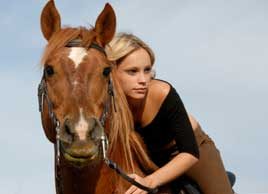Fitness trend: Horseback riding
Strengthen your leg muscles and improve your posture and balance with horseback riding

Source: Best Health Magazine, October 2012; Image: iStock
Kat Lipinski is an apprentice funeral director and a single mom, so let’s just say her life has its stressful moments. But for the past year, she has been spending time with the horses and fellow riders at Bay Ranch Lodge & Equestrian Centre in Bobcaygeon, Ont., and has found that it’s an amazing way to decompress. ‘It’s my version of meditation,’ says Lipinski, 32, who lives in Lindsay, Ont. ‘I think it’s the connection with the animals. It’s like an escape from everyday life.’
Last fall, Lipinski, who took riding lessons about a decade ago, jumped at the chance to rescue an injured racehorse named Ember, who had sustained a broken bone while racing and was going to be put down. Lipinski now spends about an hour and a half each day at Bay Ranch, grooming Ember (who isn’t ready to be ridden yet) and walking in the ring with her. ‘She’s learning how to be a horse again, rather than a racehorse,’ says Lipinski. Her friend Emma Elley, owner of Bay Ranch, has also been giving Lipinski lessons on another horse to help her brush up on her skills.
Working with and riding horses is a good light workout, Lipinski says. ‘It strengthens your leg muscles and makes you stronger all over.’ It helps to improve posture and balance, too. The various activities associated with horses’from saddling and grooming to riding’burn a range of calories: In a 155-lb. woman, an hour of grooming a horse burns 422 calories, while an hour of riding a horse that’s walking burns 170. (Riding a trotting horse could burn up to 450 calories.)
For Lipinski, though, the most rewarding benefits have been social and mental. ‘It’s like a little community here; the riders get together for barbecues, and pitch in to buy things for the barn, like a fridge to keep the horses’ carrots fresh,’ she says. She and another rider, Kathy Burt, have bonded over their horses. ‘We really get along well,’ she says. ‘We encourage each other when we make a mistake with our horses, which can be very frustrating. We also laugh watching them: who’s flirting and who’s fighting. It’s like reality TV out in that field!’
How to get started
Look for an instructor certified by an organization such as Equine Canada.
Equipment
Wear an equestrian helmet with a label that shows it is ASTM/SEI-approved. These are the American and British equivalents of the Canadian Standards Association (CSA), as there is currently no CSA standard for equestrian helmets. Equestrian vests are generally required for kids under 18’and they aren’t a bad idea for adult beginners, too. The shock-absorbing vest helps protect internal organs from kicks or falls.
What to wear
Choose boots with a flat sole and a heel that stops the foot from slipping through the stirrup. It’s also recommended that you wear gloves.
This article was originally titled "Horse play" in the October 2012 issue of Best Health. Subscribe today to get the full Best Health experience’and never miss an issue!




